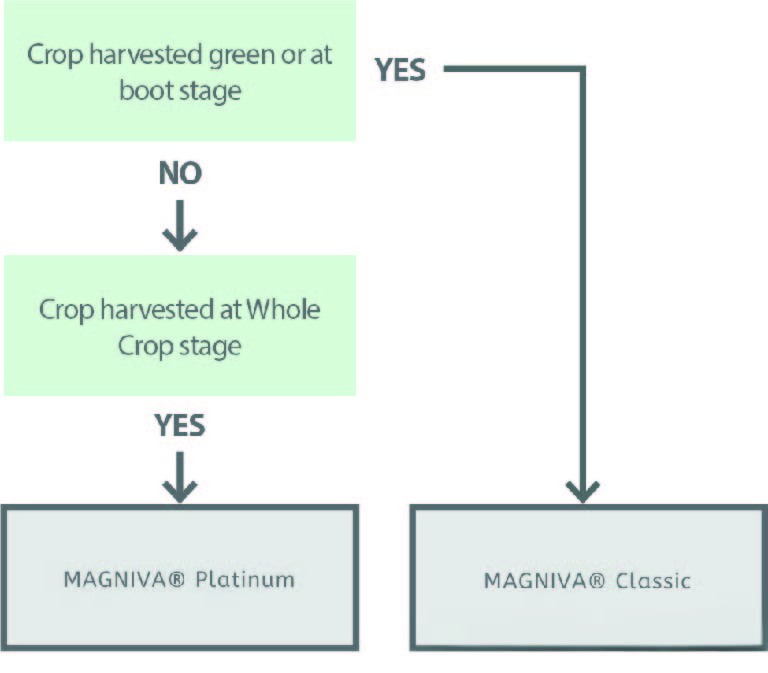Making high-performance cereal silage
Cereals provide tremendous flexibility for silage makers – they can be sown in autumn or spring and can be harvested at a range of growth stages from chopping green at the boot stage (before seed head emergence) to cutting whole crop cereals at the cheesy dough stage (when the cereal grain has the consistency of soft cheese). Cereals have the potential to be ensiled into nutritious palatable silage, which gives a good stock performance.
Crop selection
Oats are more commonly cut at the boot stage and sometimes at the milky dough stage. Barley, wheat and triticale are usually grown to harvest at the cheesy dough stage, but all three can be harvested at the boot stage. At the cheesy dough stage, barley dries down fastest so it only has a narrow window between not quite ready and too dry (in dry conditions, this can be just a few days). Triticale has the widest harvest window and can be a better option where there is less control of time of harvest.
Timing of harvest
Cutting at the boot stage will give higher protein silage with energy from the leaf’s digestibility. Cutting at the cheesy dough stage produces lower protein silage but with good energy coming from starch and more physically effective fibre. Cutting after seed head emergence but before grain fill gives lower energy silage, as the fibre in the straw is less digestible than the leaf and there has not yet been sugar and starch accumulated in the grain.
Additive selection
Cereal silage cut at the boot stage usually has a lower dry matter (DM) % and high protein content, requiring more acid production during fermentation. MAGNIVA® Classic contains large numbers of lactic acid bacteria to ensure a fast efficient fermentation, making it ideal for this type of silage.
Cereals cut at the cheesy dough stage naturally ferment quickly, as they have a higher DM%, high starch and low protein content. However, high starch silage is more prone to heating at feed out due to yeast and mould growth. MAGNIVA® Platinum is the most suitable inoculant for whole crop silage as it improves silage stability at feed out.
Nutritech range of inoculants are EU registered and contain known levels of live bacteria, so you can be sure you’re saving the nutritional quality of your crop.

Compaction
Cereal silage cut at the boot stage must be wilted before ensiling to avoid silage effluent (leachate). For pits and stacks, ensiling at 30-35% ensures no effluent but the crop can still be well compacted. For bales, wilting to 35% ensures good bale shape and compaction.
When cereal plants reach the cheesy dough stage, the plant should be dry enough to direct cut – the target is 38% DM. At this growth, stage plants can be drying fast, and a crop can go from ‘not quite ready to ‘too dry’ in a matter of days, so vigilance is crucial. Once the crop is over 40% DM standing, it can be hard to compact – chopping shorter and packing in thin layers will help. When baling cereals at the cheesy dough stage, it is best to err on the early side and use knives in the baler to help with the compaction. Poorly compacted bales are more likely to go mouldy.
Sealing
As cheesy dough cereal silage is prone to aerobic spoilage (such as caused by yeasts and moulds when air is present), it is important to seal it well to keep the air out once good compaction has been achieved. Using Silostop® oxygen barrier film will reduce aerobic spoilage losses in the top metre which is particularly beneficial for cereal silage. Independent testing has confirmed that Silostop® oxygen barrier film is 60 times more effective than conventional black/white film in preventing oxygen transfer into silage. Re-usable Silostop® Anti-UV Cover can be used on top of Silostop® with gravel bags, removing the need for tyres and reducing the amount of plastic use.
For bales, use at least six layers of quality wrap and move wrapped bales either within a day or after they have fermented, to avoid ‘popping’ bales when they are lifted and damaging the integrity of the wrap. Bales should be stored on a suitable free-draining site, stacked no more than 2 high, and not jammed up hard against each other.
Pest control
Whole crop cereal silage is often referred to as a ‘rat magnet’ as it is so attractive to rats and mice. Baiting needs to be done early before the rats and mice are established in the silage. It also helps to spray out the ground around the silage so there is no cover for rodents, particularly along the sides of tubes and ag bags. Birds are also attracted to whole crop cereal silage, they pick out the grains from the exposed silage face and leave the straw. Nets can be used to keep birds off the face.
Feedout management
Once stacks and pits are opened and the silage face is exposed to air, yeasts and moulds can start to grow, resulting in nutrient loss and the risk of mycotoxins. To minimize losses, the removal rate should ensure the face returns at least 30cm daily. Making a narrower, longer stack can help achieve this for lower stock numbers. A block cutter keeps the silage face smooth with minimal air penetration. Using MAGNIVA® Platinum inoculant increases the time that silage can be exposed to air at feed out before it starts to heat.
How good is your silage?
If you want to know how good your silage is, and how you could improve it for next season, then the Nutritech team are well equipped to help. Not only can they help with silage sampling, they also have a range of tools for assessing silage at the stack face or bale.
